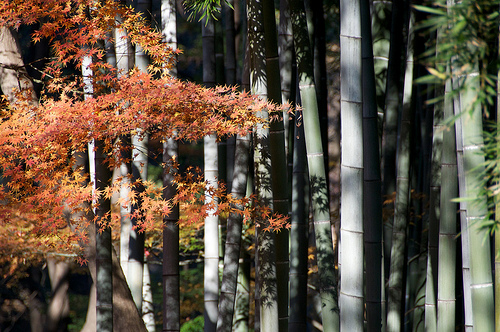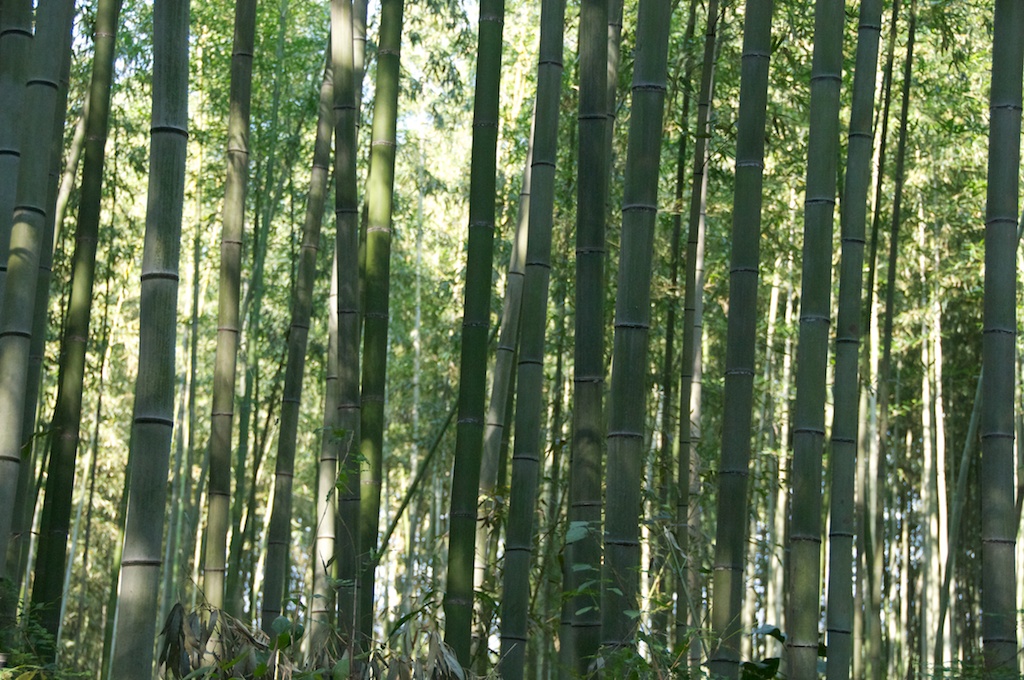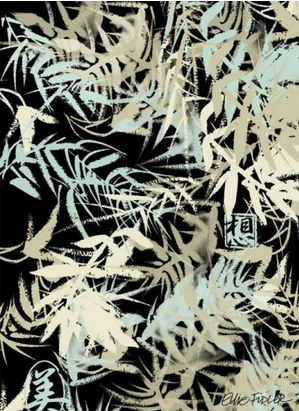118. The "Bamboo" Radical: 竹
The "bamboo" radical 竹 is essentially straightforward. This symmetrical six-stroke radical is always called "bamboo" in English. Just as the Joyo kun-yomi of the autonomous kanji 竹 is たけ, we can refer to this radical as たけ. However, when it sits atop a character in a more compressed form, たけかんむり is the appropriate name. We can use たけかんむり for 24 of the 25 Joyo kanji with this on-duty radical, such as the following character:
策 (873: scheme; policy, measure)
The 25th kanji is 竹 (170: bamboo) itself.
In the rest of this Radical Note, when you see a kanji that includes 竹, you can be sure that it's the on-duty radical, not a mere component.

Henshall says that although 竹 is often believed to depict bamboo segments, early forms represent "stems of dwarf bamboo with spiky leaves."
Images of the ancient 竹 from Sears's page are nothing like the 竹 shape we see today. If anything, the first one looks like an upside-down "grass" radical in its old form, 艸.

Photo Credit: Christopher Acheson

Photo Credit: Christopher Acheson
The Bamboo Connection
It's easy to imagine why there's bamboo in all of the following kanji:
筆 (569: brush, writing instrument, writing)
籠 (1983: basket; cage)
箸 (2094: chopsticks)
After all, people originally made those items out of bamboo and sometimes still do.
I assumed the same about several other kanji, but their etymologies in Henshall surprised me. For example, consider this character:
箱 (1703: box)
Surely boxes were first made of bamboo, right? Wrong! The part beneath our radical in 箱 acts phonetically to express "both sides." This character originally referred to bamboo frames put on either side of a cart. It then came to mean "container" or "box" more broadly.
The next etymologies involve bamboo used as a pipe or tube:
管 (443: pipe; to exercise control)
Originally, says Henshall, 管 depicted "pierced bamboo that controlled sound" (i.e., a wind instrument) but came to represent any kind of pipe, as well as "control." What a fascinating divergence in meanings!
笛 (1624: woodwind instrument; whistle; horn)
Kanjigen says that the 由 phonetic comes from 抽, which means “to extract through a small hole.” Thus, 笛 represents an “instrument that makes sounds by pulling air through a bamboo pipe.”
筒 (1655: tube)
The 同 component acts phonetically here to express "to pass (clear) through" and maybe "round," according to Henshall. A (round?) bamboo with a clear passage through it would be a bamboo tube.
Here's one more Henshall etymology that does reflect bamboo, but not its use as a wood. Rather, the history alludes to the unusual segmentation in this plant:
節 (523: joint, node; season of the year; time; festival; paragraph; tune; to economize, be moderate; moral integrity; bamboo tally used in ancient China)
The part under our radical acts phonetically to express "division," also lending an idea of "order" (from the seating order at a table). All together, 節 meant "ordered division of bamboo," a reference to the way its nodes and sections are ordered. From there the meanings extended in various directions.
Photo Credit: Eve Kushner
From left to right, here are the kanji on this sign:
竹工芸 翠屋
Bamboo Craft Midoriya
竹工芸 (たけこうげい: bamboo craft);
翠屋 (みどりや: "green store")
The 翠 is non-Joyo. The store, which is in the incredible Yanaka Ginza area of Tokyo, sells baskets, chopsticks, and the like made of bamboo. Note that the sign is made of wood, not bamboo!
Unexpected Uses of 竹
If you like surprises, Henshall provides many others where our radical is concerned. For instance, he says that although it's almost unheard of, the "bamboo" radical acts as a phonetic in two Joyo kanji:
答 (185: answer)
篤 (1666: cordial, courteous; serious, earnest; devoted)
With regard to 篤, Henshall says that 馬 is "horse" and that 竹 uncharacteristically serves as a phonetic that expresses "step," possibly also lending connotations of "strong but supple." He says that 篤 originally referred to a "horse stepping surefootedly (with suppleness and strength?)."
As for 答, Henshall presents a complicated discussion. The relevant part here is that "most unusually for a radical, 竹 is used phonetically." In 答 it expresses "firm." (Kanjigen disagrees, saying that 答 has no phonetic.)
The next kanji also has an unexpected connection to firmness:
箇 (1054: counter for things; item, place)
The 固 means "hard, solid." Originally, says Henshall in his newer edition, 箇 was a counter for lengths of bamboo.
Given its firmness and its tendency to splinter, bamboo is an unlikely thing to find in the body. Nevertheless, consider these two kanji:
笑 (900: to laugh, smile)
筋 (843: muscle; threadlike structure)
Actually, 笑 didn't originally contain bamboo. The top part is a longstanding miscopying of the "grass" radical. The bottom part was also confused with another kanji.
As for 筋, Henshall says that the 肋 means "rib"—namely, that which gives strength to the flesh. The ribs of a bamboo plant are its "fibers," he says, noting that 筋 originally meant "fibers." This character came to mean "thread," with "sinew" and "muscle" being associated meanings.
It's easy for all these words to fly by like so much "blah blah blah." Let's take a moment to consider how wonderful that image is. Ribs strengthen a mammal's flesh, just as bamboo fibers strengthen a plant. And 筋 started out meaning "fibers" but then turned into "muscles." So in a sense, there are rib bones (肋) inside muscles (筋)!
Photo Credit: Eve Kushner
Sign for an izakaya (bar, pub) called 笑太 (しょうた). Look how our radical has turned into a pair of eyes! Although 笑 has the Joyo on-yomi of ショウ, the typical ways of writing the given name しょうた are 翔太 and 将太. (The non-Joyo 翔 means "to soar," and 将 means "commander; general; leader.") Using 笑 in this name may be wordplay.
Bamboo Tallies
We saw the word "tally" in one definition of 523 (節)—that is, "bamboo tally used in ancient China." Henshall also mentions tallies in his etymologies of these two kanji:
籍 (1486: register)
符 (1753: symbol, sign, mark)
For 籍, he says that the lower left part may represent a "serrated piece of wood" or a "tally" or "pledge."
With 符, Henshall says that the radical indicates a "bamboo tally cut in two and then joined upon fulfillment of an agreement." As the 付 means "to join," 符 originally meant "to join tallies" but later came to refer to the tally itself.
All that is fine, but what in the world is a tally?!
In defining 符, Halpern says that particularly in ancient China, people would split tallies of wood or bamboo in half and use those pieces for identification. So was a tally like a driver's license? Or was it more like the tag one would attach to luggage?
Wrong on both accounts! Wikipedia says that tallies (符) were typically made of bamboo or wood, though metal (gold, silver, bronze) and jade were also possible. They were mostly shaped like tigers, but dragons, turtles, snakes, fish, and humans were also possible shapes.
People used tallies as proof of authorization. For instance, a king would have two-piece set of tiger tallies (虎符) and keep one piece with the central government while issuing the matching piece to army officials. Before commanding troops to leave a certain area, an army officer would need to show the correct tally, proving that he had the right to make such an order. Ah, a pre-electronic password!
Photo Credit: Gary Lee Todd
A tiger tally from the second century BCE. Made of bronze with gold inlay, this tally was found in a king's tomb in Guangzhou, China.
Counting Things and Keeping Records
I thought tallying was about counting, so it made perfect sense to me to see three kanji related to tallies and then several more about quantifying things or keeping records. Now I know that there's no connection whatsoever! Anyway, these five kanji involve counting or record keeping:
算 (128: calculation)
第 (339: ordinal number suffix)
等 (361: equal, same; class, rank, etc.)
簡 (829: simple)
簿 (1790: record book)
That is, 算 originally meant "to use a bamboo abacus" and has evolved to mean "to calculate." (Scholars believe that the bottom part shows two hands holding an abacus.)
In the other four, the 竹 represents "bamboo tablets used for keeping records." I've never seen continuity across that many kanji! Henshall differentiates them in this way:
第 (339: ordinal number suffix): The part that isn't 竹 has to do with "order," so 第 means "to put bamboo tablets in order," leading to "order/sequence" in general.
等 (361: equal, same; class, rank): The 寺 acts phonetically to express "arrange." Thus, 等 means "to arrange bamboo tablets" by hand, which has to do with putting them in equal groups, which extended to various meanings such as "class" and "equal."
簡 (829: simple): The 間 means "space." Thus, 簡 is a "bamboo record with space (left)," indicating that the record is simple and brief. That's very cool—and simple and brief!
簿 (1790: record book): The bottom part means "extensive," also acting phonetically to express "to bind." Thus 簿 referred to "an (extensive?) collection of bamboo tablets bound together," which is to say "a register" or "set of records."
Photo Credit: Eve Kushner
Photo Credit: Eve Kushner
This signpost from Kamakura includes 等 (361: equal, same; class, rank, etc.), 竹 (170: bamboo), and 築 (751: to construct)! The text (which is cut off) says that in that area, one needs permission to do such things as building, rebuilding, or adding to a building; changing the character of the land; or cutting down trees or bamboo.
Three More Bamboo Items
I would be remiss if I didn't direct you to three more great bamboo-related items.
First, the late Mary Sisk Noguchi wrote a pithy and interesting Japan Times column on the "bamboo" radical as part of her Kanji Clinic series.
Second, Wikipedia has a helpful write-up of the counter ケ, explaining how it evolved from our radical.
Third, the next image is of a tea towel that doubles as a wall hanging. The artist is Ellie Fidler. Bamboo features prominently in this piece, and if you look closely you'll also see kanji!

